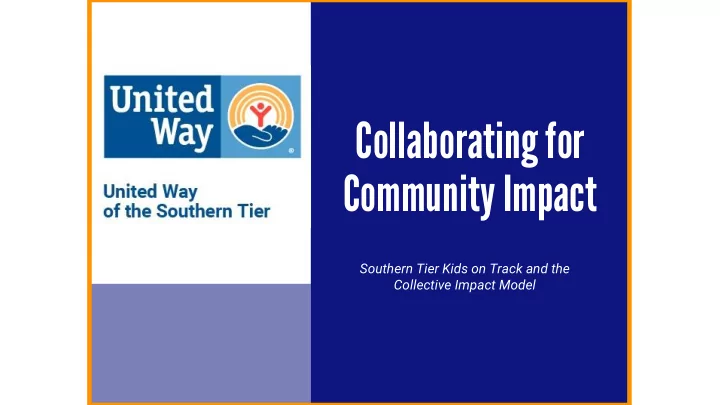

Collaborating for Community Impact Southern Tier Kids on Track and the Collective Impact Model
The science of impact • “Doing nice things for nice people” vs. • Understanding the problem and rationale for change • Aligning methodologies for change to program goals • Turning general goals into specific, measureable outcomes • Assessing strategies against outcomes • Continually learning and adjusting course for change
Large-scale social change
Why early childhood? • Critical brain development occurs within the first 3 years. • There is a direct link between academic performance at third grade and the amount of words spoken in the home from ages 0-3. • Research quantifies the correlations between poverty, failure to read proficiently and failure to graduate • As early as 18 months, income disparities begin to impact language development. Source: “The Early Catastrophe: The 30 Million Word Gap.” B. Hart and T. Risley; 2003.
Connection to the workforce • Children who are unprepared to start kindergarten often fall behind by third grade; it is nearly impossible to catch up. • Academic struggles in school are often indicators of life struggles in adulthood. • Those who struggle in school and in life will be challenged in the workforce.
Southern Tier Kids on Track
Getting kids ready • Universal home visits, beginning at birth • Build parent/caregiver capacity • Developmental screening and intervention • Optimal environments for learning • Shared responsibility for success
Operating framework
Common agenda
Theory of change
Putting the pieces together
Evolution of the science “Collective Impact” By John Kania & Mark Kramer, Winter 2011
How different is it? • Isolated intervention that alters conditions for participants of individual programs - (program/initiative-level change) vs. • Tenacious application of an evidence-based framework for guiding community-wide efforts toward a common goal • Broad-sector coordination that alters conditions at a global, population level - (community/rate-based change )
Levels of change
The Five Key Conditions Essential to success in large-scale social change efforts: • Common agenda • Shared measurement • Mutually reinforcing activities • Continuous communication • Backbone support (Version 2.0)
Common Agenda (Community Aspiration) All participants share a vision for change that includes • A common understanding of the problem • A joint approach to solving it through agreed-upon actions
Shared Measurement (Strategic Learning) All participants agree on the ways success will be measured and reported – what will be measured and why. • A short list of common indicators • A reliable system for data collection and reporting
Mutually Reinforcing Activities (High Leverage Activities) A diverse set of stakeholders engages in a set of complementary activities that magnify the shared results. • Cross-sector planning and coordination • Differentiated activities proven to contribute to the goal
Continuous Communication (Inclusive Community Engagement) Players engage in frequent and structured, open communication. • Builds trust and focus • Assures mutual objectives • Creates common motivation and accountability
Backbone Support (Containers for Change) Funded staff with the appropriate skill set is dedicated to the initiative to provide ongoing support. • Guiding the vision, strategy and mobilization of resources • Supporting aligned activities and measurement practices • Building public will and advancing public policy
Maintaining the Integrity “Collective Impact” cannot be just a buzz word. It must be • Consistently employing the five conditions of CI • A data-driven, cross sector approach • Intentional about building structures and relationships • Empowering emergent, continuous learning.
Essential Mindset Shifts Think differently… • Who is involved? • How do people work together? • How does progress happen?
A culture of learning Rather than using evaluation to determine success or failure, use that information to adapt and improve! • Ask WHAT • Ask HOW • Ask WHY • and Ask OFTEN
The Equity Imperative The missing dimension – EQUITY • The 5 conditions alone are not enough. • Without attention to equity, negative patterns can be reinforced. • Look closer at the data
Timelines for Change
Lessons Learned
Key lessons… • This is long-term, HARD work!! • It requires patience. • Complexity does not require miracles. • Success requires capacity. • We must engage the community. • The perspective of the funders must shift. • It cannot be pass or fail.
A learning environment • NOT success vs. failure • Feedback loops that openly evaluate for what works and what doesn’t, without fear of reprisal • Use data as a means for changing course, where needed • Essential to continuous, forward progress
Early wins • Common home visiting intake and referral process • Guthrie Corning Hospital participation; conversations for western expansion with U of R, Noyes, Jones • Common kindergarten assessment tool in Steuben • COMET shared database platform • Family Resource Centers
And Dolly!
Is Collective Impact for you? Readiness Assessment
Resources Tamarack Institute The Campaign for Grade Level Reading http://tamarackcci.ca http://gradelevelreading.net FSG - Collective Impact Forum Attendance Works http://www.collectiveimpactforum.org http://attendanceworks.org Center for the Developing Child, National Summer Learning Association Harvard University http://summerlearning.org http://developingchild.harvard.edu
Stay in touch! United Way of the Southern Tier 300 Nasser Civic Center Plaza, Suite 220 Corning, NY 14830 (607) 936-3753 Barbara Hubbell Senior Director of Strategic Initiatives (607) 377-5833 bhubbell@uwst.org
THANK YOU!
Recommend
More recommend